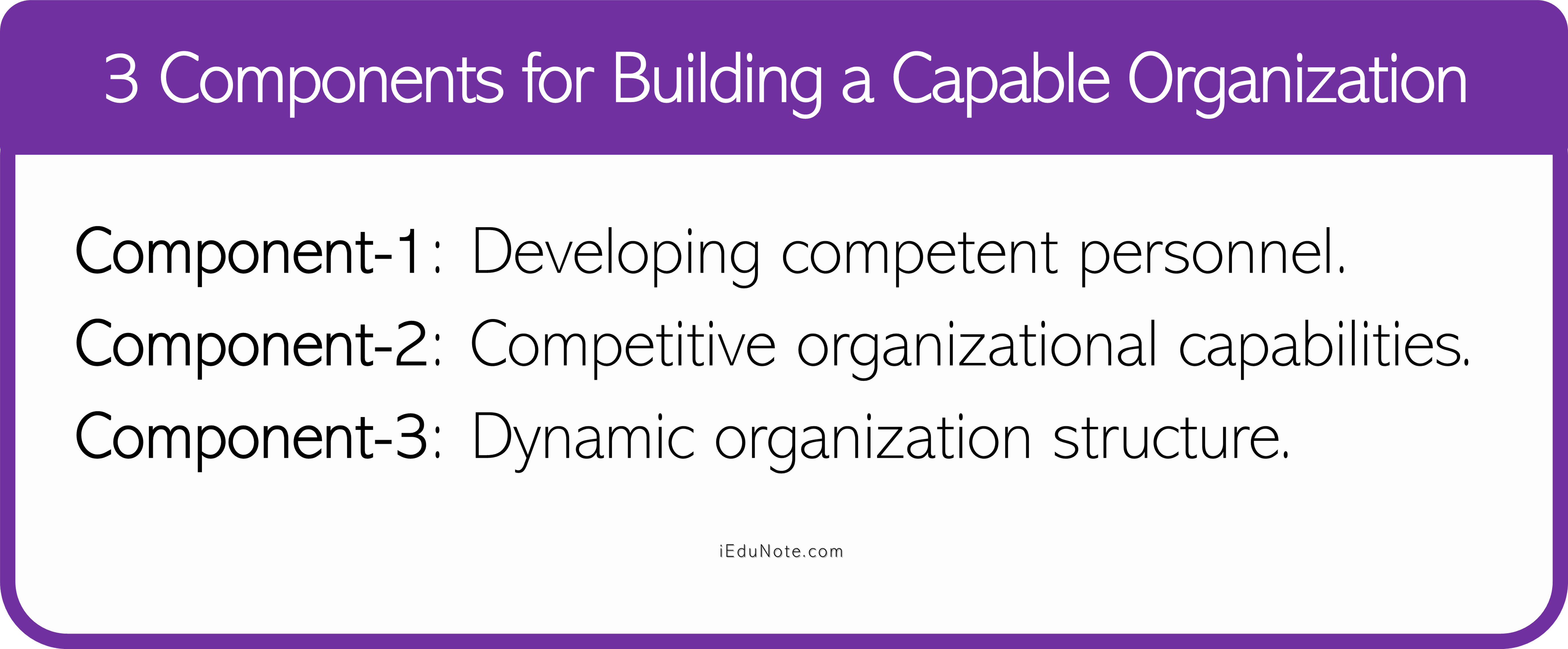In strategy implementation, a very high priority is given to building a capable organization. Giving top priority on this issue is justified because successful implementation of strategy depends to a great extent on a sound organization.
And, an organization becomes sound when its employees are competent, its management structure has matched with its requirements, and it has high competitive capabilities. These are organization-building actions concerned with effective strategy implementation.
3 Components for Building a Capable Organization are;

Component-1: Developing competent personnel
The first component of building a capable organization – competent personnel – is the first and foremost requirement for successful strategy implementation.
Developing a strong team of competent personnel may require reshaping the staffing system in the organization. If the existing management team is adequately capable of addressing strategic issues, then it’s fine.
But sometimes, it may be necessary to undertake developmental measures for strengthening the capability of existing managers and even recruiting suitably qualified managers from outside the organization.
In addition to the management team, attention also needs to be given to recruiting and retaining talented employees. Talented employees facilitate the creation of knowledge-base essential for effective strategy implementation.
Many large companies recruit the best available talent (imaginative and energetic people) and then retain them by offering a more-than-expected salary and benefits package. The people with strong skill-sets bring life to new ideas.
Component-2: Competitive organizational capabilities
The second component – competitive organizational capabilities – gives the company a competitive edge over the competitors.
Therefore, one of the most important strategies for implementing the tasks of managers is to build core competencies and competitive capabilities. This helps the company beat competitors with superior strategy execution.
Component-3: Dynamic organization structure
The third component – dynamic organization structure – requires top managers to match organization structure to strategy.
Thompson and Strickland prescribed that a customized organization structure is appropriate,’ that is, an organization structure should be situation-specific. A new strategy usually entails new competencies/capabilities arid new activities.
Consequently, it becomes a necessity for the company to make for a new internal organizational arrangement.
Although there is a need for situation-specific organization structures, there are some common considerations in the organizational structures of every company.
These are:
- identification of activities that are critical to strategic success;
- identifying non-critical value-chain activities which can be outsourced profitably;
- developing collaborative partnerships with other companies to gain’ added competitive capabilities;
- making strategy-critical activities the main building-blocks in creating organization structure (or structure must be modified to fit the strategy);
- determining the extent of centralization of authority at the top-level of the company and the degree of authority to be decentralized throughout the organization;
- providing for coordination among the various departments, processes, and geographical divisions/units; and
- assessing specific responsibility to specific persons to col labor ate with outsiders.
In fine, we can say that senior management must provide leadership in creating a capable organization by developing a strategy-supportive structure.
Senior managers also need to supplement the organization structure with coordination mechanisms and establish networking arrangements to support the implementation of strategy.
Management needs to emphasize on flatter organization structures that would be more responsive to change.
Managers of the large organizations in our country may learn lessons from the emerging organizational characteristics in some of the western industrialized countries, such as the following:
- Empowerment of managers and workers so that they can use their judgments^in their areas of work;
- Redesigning work process to ensure cohesion;
- Increased application of internet technology in the workplace and use of e-commerce business practices;
- Teamwork through the use of self-directed teams;
- Outside networking for enhancing organizational resources and capabilities;
- The pervasive use of online systems, to overcome the barriers between different departments, divisions, locations, and barriers with suppliers/strategic partners and customers;
- Extensive use of online systems for quick dissemination of information and response times to customers, suppliers.